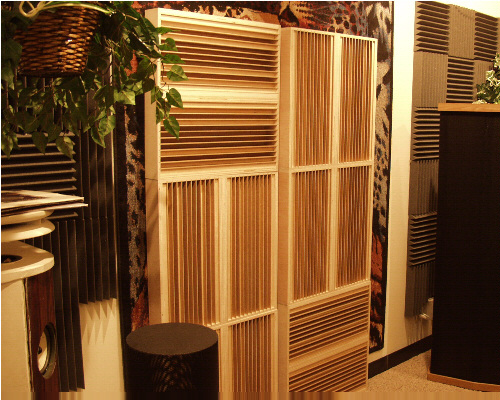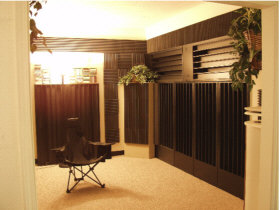ooheadsoo
Headphoneus Supremus
- Joined
- Dec 11, 2002
- Posts
- 4,835
- Likes
- 13
I'm posting this here just in case anyone is interested. These were constructed after reading many of Ethan Winer's posts and articles and a few tips taken from Jon Risch's diy panel trap.
I call it the "Ghetto Panel."
Fiberglass: 48 sq.ft. 3lb. pcf 2" Certainteed brand rigid fiberglass panels(6) - ~$71
Burlap: $3 a yard, ~$4.65 per panel, total x 4- ~$18.60
Frame materials: lumber - $1.09 a piece x 6, 4 packages of corner braces $2.74ea., upholstery nails x 2 $1ea. - ~$21
Total ~ $111
Please note though I purchased 6 panels of fiberglass, I only purchased enough other materials to assemble 3-4 traps. For 2 more panels, you would probably need another $22 or so.
Tools: drill, philips screwdriver, hammer

Here's what the raw panel looks like for those who don't know. (I didn't.)

Some tools, minus hammer.

The lumber cut up by a home depot employee. When choosing the lumber, I asked for the cheapest 1x2 they had. A good thing to do is to try to pick pieces that are actually flat. I wanted to get on to making my panels so I didn't pay attention to it. It's not bad, but for those perfectionists...you probably already knew that didn't you?

Here's that bracket I chose. You can probably save a buck or two by buying cheaper brackets without included screws and buying the screws separately...but I wanted to go build my panels, not hunt down screws It also would probably be easier to use a flat bracket unlike the ones I chose.
It also would probably be easier to use a flat bracket unlike the ones I chose.

Here's the assembled frame. I predrilled holes for the brackets and then screwed them in by hand.

Here I placed the fiberglass on top of the burlap and the frame on top of the fiberglass. Then I flipped it over and nailed in like so:

I used 2.5" nails I already had lying around the house.
After nailing the fiberglass to the frame, flip it over so that the fiberglass side is facing the burlap. Then, fold the edges of the burlap over and use those thumbtacks/whatever to secure them.

Flip it over when you're done and this is what you get: Genuine Ghetto Panel.

Takes me about an hour per panel. Use more thumbtacks if you can spare them. The burlap loosens up by itself over time and the creases diminish. You could consider ironing it I guess...
I call it the "Ghetto Panel."
Fiberglass: 48 sq.ft. 3lb. pcf 2" Certainteed brand rigid fiberglass panels(6) - ~$71
Burlap: $3 a yard, ~$4.65 per panel, total x 4- ~$18.60
Frame materials: lumber - $1.09 a piece x 6, 4 packages of corner braces $2.74ea., upholstery nails x 2 $1ea. - ~$21
Total ~ $111
Please note though I purchased 6 panels of fiberglass, I only purchased enough other materials to assemble 3-4 traps. For 2 more panels, you would probably need another $22 or so.
Tools: drill, philips screwdriver, hammer

Here's what the raw panel looks like for those who don't know. (I didn't.)

Some tools, minus hammer.

The lumber cut up by a home depot employee. When choosing the lumber, I asked for the cheapest 1x2 they had. A good thing to do is to try to pick pieces that are actually flat. I wanted to get on to making my panels so I didn't pay attention to it. It's not bad, but for those perfectionists...you probably already knew that didn't you?

Here's that bracket I chose. You can probably save a buck or two by buying cheaper brackets without included screws and buying the screws separately...but I wanted to go build my panels, not hunt down screws

Here's the assembled frame. I predrilled holes for the brackets and then screwed them in by hand.

Here I placed the fiberglass on top of the burlap and the frame on top of the fiberglass. Then I flipped it over and nailed in like so:

I used 2.5" nails I already had lying around the house.
After nailing the fiberglass to the frame, flip it over so that the fiberglass side is facing the burlap. Then, fold the edges of the burlap over and use those thumbtacks/whatever to secure them.

Flip it over when you're done and this is what you get: Genuine Ghetto Panel.

Takes me about an hour per panel. Use more thumbtacks if you can spare them. The burlap loosens up by itself over time and the creases diminish. You could consider ironing it I guess...







